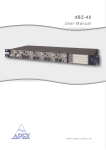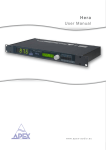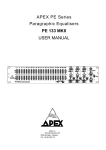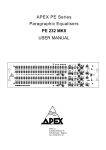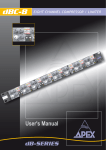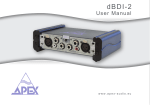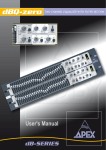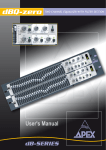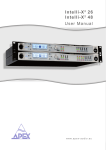Download Apex Digital dBZ-48 User manual
Transcript
dBZ-48d User Manual www.apex-audio.eu APEX NV Schoebroekstraat 62 3583 Beringen (Paal) BELGIUM Tel: + 32 (0)11 28 61 91 Fax: + 32 (0)11 25 56 38 e-mail: [email protected] website: www.apex-audio.eu Trademarks The APEX trademark is owned by APEX N.V. All other brand, product and company names and any other registered names or trade marks mentioned in this manual belong to their respective owners. Disclaimer APEX N.V. has taken all possible steps to ensure that the information given here is both correct and complete. In no event can APEX accept any liability or responsibility for any loss or damage to the owner of the equipment, any third party, or any equipment which may result from use of this manual or the equipment which it describes. The information provided in this document may be modified at any time without prior warning. Specifications and appearance may differ from those listed and illustrated. Any complaint against APEX N.V. shall be governed by the laws of Belgium. dBZ-48d Stereo zone mixer with with built-in DSP March 2010 Serial number of this product: © 2010 APEX N.V. All rights reserved. This manual may not be reproduced or transmitted, either in part or as a whole, by any means, be they mechanical or electronic, without the express written permission of APEX N.V. Important safety instructions Important safety instructions CAUTION: to reduce the risk of electric shock, do not remove cover (or back). No user-serviceable parts inside. Refer servicing to qualified service personnel. The lightning flash with arrowhead symbol, within equilateral triangle, is intended to alert the user to the presence of uninsulated “dangerous voltage” within the product’s enclosure that may be of sufficient magnitude to constitute a risk of electric shock to persons. The exclamation point within an equilateral triangle is intended to alert the user to the presence of important operating and maintenance (servicing) instructions in the literature accompanying the appliance. Instructions Before installing or operating the equipment, read all safety instructions, warnings and operating instructions. Heed all warnings. Follow all instructions. Keep all safety, installing and operating instructions for future reference. Installing and operating location Do not use this apparatus near water. Do not expose this apparatus to drips or splashes. Do not place any objects filled with liquids, such as vases, on the apparatus. Do not install near any heat sources such as radiators, heat registers, stoves, or other apparatus (including amplifiers) that produce heat. No naked flames, such as lighted candles, should be placed on the apparatus. The apparatus should be located close enough to the AC outlet so that you can easily grasp the power cord plug at any time. The mains plug, the appliance coupler or the mains switch is used as the disconnect device. Either device shall remain readily operable when the apparatus is installed or used. Power source and grounding This product should be operated only from the power source indicated on the apparatus or in the operating instructions. If you are not sure of the type of power supply to your home, consult your product dealer or local power company. Do not defeat the safety purpose of the polarised or grounding-type plug. A polarised plug has two blades with one wider than the other. A grounding type plug has two blades and a third grounding prong. The wide blade or the third prong is provided for your safety. If the provided plug does not fit into your outlet, consult an electrician for replacement of the obsolete outlet. Connect Class I construction apparatus to an AC outlet with a protective grounding connection. Do not overload wall outlets, extension cords or integral convenience receptacles, as this can result in a risk of fire or electric shock. Protect the power cord from being walked on or pinched, particularly at plugs, convenience receptacles and the point where they exit form the apparatus. Do not install the apparatus in a confined space such as a book case or similar unit. Do not block any ventilation openings. Unplug this apparatus during lightning storms or when unused for long periods of time. Ensure that foreign objects and liquids cannot get into the equipment. Batteries (battery pack or batteries installed) should not be exposed to excessive heat such as sunshine, fire or the like. Never dispose of batteries in a fire as they may explode and cause injury. Install in accordance with the manufacturer’s instructions. Only use attachments/accessories specified by the manufacturer. Use only with the cart, stand, tripod, bracket or table specified by the manufacturer, or sold with the apparatus. When a cart is used, use caution when moving the cart/apparatus combination to avoid injury from tip over. CAUTION: Danger of explosion if battery is incorrectly replaced. Replace only with the same or equivalent type. Cleaning, maintenance and servicing Unplug the apparatus from the wall outlet before cleaning. Do not use liquid cleaners or aerosol cleaners. Use a damp cloth for cleaning. Do not attempt to service this product yourself, as opening or removing covers may expose you to dangerous voltage or other hazards. Refer all servicing to qualified service personal. Customer participation is important to minimize the potential affects on the environment and human health that can result from hazardous substances that may be contained in this product. Please, dispose of this product and its packaging in accordance with local and national disposal regulations including those governing the recovery and recycling of waste electrical and electronic equipment. Contact your local waste administration, waste collection company or dealer. Servicing is required when the apparatus has been damaged in any way, such as power-supply cord or plug damaged, liquid has been spilled or objects have fallen into the apparatus, the apparatus has been exposed to rain or moisture, does not operate normally or has been dropped. Intended use The equipment may only be used for the purpose described in the operation instructions. Never carry out any work on the equipment other than as specified in the operating manual. Never push objects of any kind into this product through openings, as they may touch dangerous voltage points or short-cut parts, which could result in a fire or electric shock. Children should never use the apparatus without close adult supervision. WARNING: excessive sound pressure levels can cause hearing loss. Environmental precaution Electrical and electronic equipment may contain hazardous substances for humans and their environment. The “crossed out wheelie bin” symbol present on the device and represented above is there to remind one of the obligation of selective collection of waste. This label is applied to various products to indicate that the product is not to be thrown away as unsorted municipal waste. At the end of life, dispose of this product by returning it to the point of sale or to your local municipal collection point for recycling of electric and electronic devices. Table of contents Table of contents Registration Introduction Product highlights Foreword 7 Before you get started 9 9 9 9 9 9 About this manual Inspection and unpacking Operating environment Power requirements Installation 8 8 8 Front and rear panel description Front panel Rear panel 10 Overview 12 Wiring the unit Overview dBZ-48d Block diagram 12 12 13 Using the dBZ-48d 14 Mono operation Menu system and navigation Preset submenu Audio submenu Settings submenu Menu flowchart 14 14 15 15 17 18 Applications 19 Small bar-type venue House of Worship Audio to video synchronization 19 20 21 Technical specifications 22 Electrical specifications Mechanical specifications 22 23 Limited Warranty 24 10 11 Registration Register your product Please take the time to register your product on-line by typing the following URL in your browser: http://productregistration.apex-audio.eu/ As well as registering the product on-line, please take the trouble to record the serial number of the unit in the space provided on page 3 of the manual, and keep the manual in a safe place. In memory of our friend Robert Van Aenroyde, electronic audio engineer. Introduction Dear customer, Thank you for buying the Apex dBZ-48d. The dBZ-48d is a professional quality, DSP-equipped 2-into-4 stereo zone mixer designed to manage audio distribution and time alignment in a variety of sound reinforcement applications including live PA and installed sound systems. Product highlights • Two stereo input channels • Four stereo output channels • Electronically-balanced inputs • High-quality, servo-balanced output stages, capable of driving long cables • Stereo/mono switch on each input and output channel, with LED indication • Mute button on each input and output channel, with LED indication • LED signal metering for L & R on each input and output channel • Integral DSP (Digital Signal Processing) section, providing: • Adjustable delay for each output channel, 0 – 1 second • Hi- and lo-pass filters in each output channel • Polarity (phase) switching for output channel • Delay can be specified in units of ms, distance or video/film frames • Temperature compensation for delay calculations (°F/°C) • 8 presets for storing all DSP settings • DSP by-pass for each output channel • Simple menu system with LCD display • Rugged all–metal chassis • Professional quality XLR connectors throughout • 1U 19” rack-mounting unit Foreword The Apex dBZ-48d can be used in any situation where one or two stereo audio signals need to be routed and mixed at different levels to up to four destinations. Common areas of application are as zoners/distribution amplifiers in installed audio situations, as time alignment devices for sound reinforcement systems, and to provide audio/ video synchronisation. When used as a zoner, any of the four outputs may receive either of the two inputs at any level, or a mix of them. Mono/stereo switching on both the inputs and the outputs makes matching the unit to a variety of sources and speaker systems simple. Filtering can be applied to individual outputs to tailor the signal to suit the acoustics of the area being driven. An alternative installed sound application is to use the unit as a distribution amplifier (DA), to drive rows of loudspeakers in an auditorium. It is common practice to drive speakers further from the stage at a higher level, and to introduce delays to time-align the speaker rows accurately. When used with a sound reinforcement system, the dBZ-48d can be used as a simple electronic crossover. The filters may be set to configure any two output channels as a two-band crossover; two pairs of outputs may be set differently to suit different speaker systems. Another live sound application is to use the dBZ-48d to derive the feeds for a system’s delay towers; time delays can be accurately added to each output channel, calculated automatically from distance and temperature data. The dBZ-48d is also extremely useful in providing finelyadjustable audio delays to enable accurate audio/video synchronisation at live events. Video processing generally introduces signal delays in discrete numbers of video frames; the dBZ-48d’s delays can be adjusted in frames to simplify this process. Before you get started About this manual Power requirements Carefully read all instructions and warnings before operating this appliance. Keep this manual in a safe place so that it can be referred to when required. BEFORE you connect any unit to the mains, please make sure that your local AC supply is within the range of voltages required by the unit. This manual describes dBZ-48d internal software version v1.0. Latest manual revision can be downloaded from: http://www.apex-audio.be/manufacturing/support/downloads/ The dBZ-48d is designed to work from an AC supply between 100 V and 240 V, at a frequency between 50 and 60Hz. No AC voltage selector is provided as the device automatically adjusts to the incoming AC voltage. Inspection and unpacking Precautions should be taken so that the appliance is properly grounded at all times. This unit must be earthed. This appliance has been carefully packed in the factory and the packaging was designed to withstand rough handling. Should the unit appear to have been damaged in transit, do not discard any of the packing material and notify the carrier immediately as they would be responsible. Save all the packing materials for future use if you ever need to ship the unit again. Please check the list below against the contents of the packaging. If any items are missing or damaged, contact the Apex dealer or distributor where you purchased the unit. • dBZ-48d unit • IEC AC power cable with mains plug • This manual Installation If the unit is brought into a warm room from a cold environment, internal condensation may occur. Wait an hour or two before switching it on so that it can reach the ambient temperature. Although this unit is intended for installation in a standard 19-inch rack it can nevertheless be used freestanding. If the unit is installed in a flight-case or in an equipment rack, fix the unit with all four screws through the front panel holes. For normal use no extra support is needed, but in more extreme conditions, such as on the road, we recommend the unit is supported at the rear. Allow at least 10 cm (4 inches) at the back, front and sides of the unit for sufficient ventilation. Operating environment This appliance is designed to operate in moderate climates at a temperature between 5 and 40°C (41 - 104°F) with relative humidity no more than 60 %. Should the unit be installed in an equipment rack, it is important to ensure that the operating temperature inside the rack does not exceed the upper limit. This could be the case where the rack contains power amplifiers. A cooling fan may be necessary in such installations. Front and rear panel description Front panel 4 7 12 13 6 5 14 19 20 11 16 2 8 9 17 Front panel Input Controls: Front panel controls for IN A are described: those for IN B are identical. 1 IN A LEVEL is a stereo control adjusting input stage gain, with range from -∞ to +6 dB. The control is centre-detented at unity gain (0 dB). 2 Pressing the latching MUTE button removes Input A’s signal from all outputs. 3 Red LED indicates Input Mute [2] is active. 4 The Left and Right channels of the Input may be summed with the MONO button. A 6 dB pad is inserted in mono mode to maintain mono/stereo level compatibility. 5 Green LED indicates Input Mono [3] is active. 6 Three LEDs indicating signal level for each channel of the stereo input: the green sig LED illuminates at -20 dBu; two further yellow LEDs illuminate when the input level is +4 dBu and +10 dBu respectively, with the LEVEL control set to zero. The meters are post the input level control [1], and therefore can be used when this is adjusted. However, they are pre the mute button [2], and thus will continue to indicate the presence of an input signal even when the mute is active. The meters possess PPM-style ballistics (fast attack, slow decay). 7 A separate red Peak LED indicates that the signal level is within 1 dB of clipping. The signal is monitored before the level control [1] as well as at the metering point. Output Controls: Front panel controls for OUT 1 are described: those for OUTS 2 to 4 are identical. 8 OUT 1 MIX A is a stereo control adjusting the level at which Input A signal is fed to Output 1. The range is from -∞ to +6 dB. The control is centre-detented at unity gain (0 dB). 9 OUT 1 MIX B has an identical function to [8] for Input B. 10 Pressing the latching MUTE button mutes Output 1 completely. 10 18 10 3 1 15 22 23 21 11 Red LED indicates Output Mute [10] is active. 12 The Left and Right channels of the Output may be summed with the MONO button. As with the input mono function, a 6 dB pad is inserted to maintain mono/stereo level compatibility. 13 Green LED indicates Output Mono [12] is active. 14 A set of meters is provided with characteristics identical to those of the input meters [6]. The output metering point is post both the Mix controls [8 & 9] and the Output Mute button [10]. 15 A separate Clip LED indicates that the signal level is within 1 dB of clipping. The signal is monitored before the Mix controls [8 & 9] as well as at the metering point. 16 If the unit is being used purely as a zoner or distribution amplifier with no DSP functions being required (delays, filtering, etc.), the DSP section for the output section may effectively be switched out of the signal path with the DSP BYPASS button. 17 Yellow LED indicating that the DSP section is bypassed. Other front panel features: 18 The 2-row x 16-character LCD display allows control of the dBZ-48d’s DSP section. 19 Rotary control for menu navigation, data entry, etc. The control can also be pressed inwards, to perform an “Enter” action in the menu system. 20 The Menu/Undo button gives entry to the menus, and also performs an ‘Undo’ function in certain parts of the menu system. 21 Navigation between menu items is with the rotary encoder/ Enter control and the Up/Down buttons. Pressing and holding these buttons simultaneously also activates a front panel lockout function. A full description of the menu system is given later in this manual. 22 The green Power LED illuminates when AC power is applied to the unit. The dBZ-48d’s power switch is on the unit’s rear panel. 23 The dBZ-48d may be mounted in a standard 19” rack housing. Please observe the guidance regarding ventilation. Rear panel 2 3 7 4 1 6 5 Rear panel All connections to the dBZ-48d are made via the rear panel. 3 IEC receptacle for AC mains. Rear panel connections for IN A are described: those for IN B are identical. Similarly, the details of the output connections are identical for all four channels. 4 A ‘POWER switch of the ‘rocker’ type applies power to the unit. 1 Input A L & R. Inputs are on latching 3-pin female XLRs, with separate connectors for left and right channels. The inputs are electronically balanced. The pinout is as shown below: PIN 1 GND 2 ‘Hot’ ( + ) 3 ‘Cold’ ( - ) XLR (female) 5 Mains fuse holder. The fuse size is 20 x 5 mm, type T500mA (slo-blo). Only replace a fuse with one of an identical size, type and rating. 6 A 9-pin D-type connector (RS-232) is fitted for the purpose of updating the dBZ-48d’s firmware. This procedure should only be performed by an Apex distributor. Note that this connector has no other function. 7 The unit’s serial number can be found on the rear of the unit. Please record this number in the space provided on the first page of this manual. 2 Output 1 L & R. Outputs are on 3-pin male XLRs, with separate connectors for left and right channels. The outputs are electronically balanced. The pinout is as shown below: PIN 1 GND 2 ‘Hot’ ( + ) 3 ‘Cold’ ( - ) XLR (male) 11 Overview Wiring the unit The use of twin-and-screen cable is recommended for both inputs and outputs. Inputs Preferred wiring for both balanced and unbalanced sources is illustrated below: Balanced groundlift jumpers on pcb Outputs Preferred wiring for both balanced and unbalanced destinations is illustrated below: Unbalanced Balanced Unbalanced A ‘ground lift’ facility is available on the dBZ-48d’s inputs, which may be useful in resolving earth hum issues. Normally the input XLR’s pin 1 is connected to ground, but this connection may be broken by moving an internal pcb jumper. Overview The Apex dBZ-48d can be used in any situation where one or two stereo audio signals need to be routed and mixed at different levels to up to four destinations. See Block diagram on next page. Each of the two inputs is provided with electronic balancing, RFI filtering, mono/stereo switching, level control, a muting circuit and LED metering. After A-to-D conversion, the inputs are routed through the DSP section, where they are split to the four output channels. Delay, filtering and polarity (phase) are implemented by DSP on a per-output channel basis. After D-to-A conversion, the level of each input signal fed to each output channel may be 12 individually set. Again, mono/stereo switching, muting and LED metering are available for each output. The servo-balanced output stage design results in a very low output impedance, making it possible to drive long balanced lines (e.g., from a FOH mix position to stage amp racks). Note that the DSP processing (delay, filtering and polarity...) precedes the mixing stage (where inputs A and B are combined), and that the mixing is in the analogue domain. This architecture allows rapid level/mix adjustments in “real-time”, without any delay between making the adjustment and hearing its effect. dBZ-48d Block diagram 13 Using the dBZ-48d Using the dBZ-48d Operation of the dBZ-48d’s analogue input and output sections is entirely straightforward, and requires only correct adjustment of the respective level controls. Start with all the front panel rotary controls fully anticlockwise. Connect the stereo input source(s) to IN A and IN B and the stereo outputs to their respective amplifiers (or other signal processing) as appropriate. With the programme material present, rotate the input level controls until the second (+6dB) LEDs flash on the loudest peaks, but so that the red CLIP LEDs do not illuminate. Then rotate the output level controls for each output channel in turn to obtain a similar display on each pair of output LED meters. All DSP parameters are adjustable from the front panel via the menu system and alphanumeric display. The dBZ-48d also provides eight memory presets enabling configurations to be stored and recalled from the front panel. The menu system comprises three submenus: Mono operation The MONO buttons on the input channels should be used if the input in question is being fed from a mono source. In this case, the input signal may be applied to either the L or R input. If any of the outputs are to be used in mono (e.g. with the dBZ-48d in use as a zoner, it may not be practical for some room areas to support effective stereo operation), the output channel MONO buttons may be used to make an L+R sum of the stereo input signals available at both L and R outputs of a channel. This does not compromise the other output channels being used as stereo, of course. Menu System and Navigation The dBZ-48d’s DSP functions (delay time, filtering, polarity etc.) are all controlled through the menu system, using the front panel LCD display, rotary encoder and the three associated push buttons. After initial boot-up (during which the display shows the version number of the unit’s firmware), the LCD display goes to the Home Page, shown below: This is the display state during normal operation. 14 The ‘house’ symbol in the display confirms that the menu is either at the Home Page or at the top (‘Home Menu’) page of one of the three submenus (see below). The ‘closed padlock’ symbol indicates that the front panel DSP controls are locked and adjustment is not possible. An asterisk after the Preset number indicates that the Preset currently in use has had its stored parameters modified, but not saved. • Preset submenu • Audio submenu • Settings submenu To access the submenus from the Home Page, press the rotary encoder knob (the “Enter” function) or the MENU/ UNDO button. The Preset submenu’s Home Menu item is first displayed; pressing Enter will enter the actual submenu. The other two submenus (Audio and Settings) may be accessed in a similar manner by rotating the encoder from the Home Menu and pressing Enter. To exit any of the submenus, press MENU/UNDO to return to the submenu’s Home Menu page, and MENU/UNDO again to exit the submenus and return to the Home Page. Preset Submenu Preset submenu flowchart Store Preset The process of storing the unit’s set of current DSP parameters to a Preset is similar to recalling them. Preset 1 is the default; use the UP/DOWN buttons to select another. Pressing Enter opens the Are you sure? screen as above, press Enter to store the settings. Erase Preset This submenu option may be used to clear the Preset whose number is displayed, erasing its contents. Operation of the submenu option is the same as Recall Preset above. Audio Submenu Audio submenu flowchart Once the first submenu item is displayed, the rotary encoder can be used to step through the others; to select an item, press Enter while it is displayed. Recall Preset The dBZ-48d has eight Presets; these are memories which can be used to store sets of parameters for the unit’s DSP section. Preset 1 is selected initially; use the UP (K) and DOWN (J) buttons to select another of the 8 available. Pressing Enter opens an Are you sure ? screen, with No as the default response; rotating the encoder clockwise changes this to Yes. Pressing Enter then recalls the Preset and loads the stored parameters. Pressing Enter with No displayed reverts to the Preset submenu Home Menu page. If the Preset is empty – i.e., nothing has been previously saved in it – the display also reverts to the Preset submenu Home Menu page. Once the first submenu item is displayed, the rotary encoder can be used to step through the others; to select an item, press Enter while it is displayed. 15 Delay Time Polarity A delay of up to 1 second can be introduced in each of the four outputs, as required. The signal available at any output may be phase-inverted relative to the input signal. Additionally, it is possible to phaseinvert either the L or R channel on each output independently. The default state is for neither the L nor R channels of any of the outputs to be inverted. Output No.1 is selected initially; use the UP (K) and DOWN (J) buttons to select another. Delays in different outputs can easily be compared using these buttons. To vary the delay, press Enter and use the rotary encoder. Default units are milliseconds; alternatives are available (see Settings Submenu). A choice of coarse or fine adjustment of the delay time (when in milliseconds) may be made by using the UP and DOWN buttons; UP adjusts the time in 1 ms increments, DOWN in 20,83 µs increments (1 sample at 48 kHz sample rate). To set the displayed value, press Enter. To cancel the change press MENU/UNDO. Note that once a delay setting has been entered, if the delay units are set to anything other than milliseconds, the screen will alternate between the value set in the chosen units and the equivalent in milliseconds (with the value in brackets). However, while its value is being adjusted, the delay setting remains shown in the selected units. High-Pass Filter A high-pass filter may be inserted in any of the dBZ-48d’s outputs. Output No. 1 is selected initially; use the UP (K) and DOWN (J) buttons to select another. The filter is a fourth-order (slope of -24 dB/octave) LinkwitzRiley. The cut-off frequency (-3 dB point) is selectable from a range of twenty-one; available frequencies are at the standard ISO 1/3-octave spacing in the range 25 Hz to 2.5 kHz. The default setting is Bypass. Press Enter to adjust the filter frequency; use the rotary encoder to select a frequency, pressing Enter again to set it. Press MENU/UNDO to cancel the change. Low-Pass Filter A low-pass filter may be inserted in any of the outputs in exactly the same way as the high-pass filter. The filter is a fourth-order (slope of -24 dB/octave) Linkwitz-Riley. The range of frequencies available is from 16 kHz down to 40 Hz. Default setting is Bypass. Selection and operation of the Low-Pass Filter is identical to that for the High-Pass Filter. 16 Output No. 1 is selected initially; use the UP (K) and DOWN (J) buttons to select another. The display will indicate the current polarity of the L and R channels of the selected output with a plus sign (+) to indicate non-inversion or a phi (Ø) to indicate inversion. Press Enter to alter this; a cursor appears under the currently-selected channel. Use UP (K) to select the Right channel and DOWN (J) to select the Left channel. Then use the rotary encoder to change the polarity, pressing Enter again to accept the setting and exit. Note that if MONO is selected, both Left and Right channels must have the same phase (either in-phase or inverted), otherwise the channels will cancel and result in a strange-sounding and attenuated output. Remember that level adjustment and the mono function are performed after the digital processing ! Settings Submenu Settings submenu flowchart Temperature This parameter is only relevant if the delay units selected are of distance (feet or meters). The speed of sound in air varies slightly with temperature, and adjustment is necessary if the ambient temperature is different from the ‘standard’ temperature of 21°C. Use the rotary control to alter the reference temperature; the display shows this both in °C and °F. Press Enter to select it LCD Contrast It may be necessary to alter the characteristics of the LCD display under extreme ambient lighting conditions. Use the rotary control and Enter to adjust. Front Panel Lock To prevent inadvertent alteration of DSP parameters, the DSP section of the front panel may be locked. This includes the DSP BYPASS buttons in the output channels. Once the first submenu item is displayed, the rotary encoder can be used to step through the others; to select an item, press Enter while it is displayed. Delay Units This menu item sets the units used for delay time in the Audio submenu. The default units are milliseconds; if preferred, delays may be adjusted in meters or feet, an internal calculation being performed to translate the physical distance into time. As a further option, delay time may be expressed in terms of video frames, with frame rates of 24, 25 or 30 fps being selectable. This option should be used when the dBZ-48d is being used as an audio-video synchroniser. To lock the panel, press and hold both the UP (K) and DOWN (J) buttons simultaneously. The screen displays the message Front panel lock and the closed padlock symbol, and a timing bar of full stops moves from left to right. At the end of the timing period, the screen confirms Front panel is locked ! If the buttons are released before the time period is expired, the front panel does not lock, and the lock sequence exits. To unlock the front panel, press and hold the UP (K) and DOWN (J) buttons again; the unlocking procedure is identical to that for locking except that the word Unlock(ed) replaces Lock(ed). DSP bypass There are many applications (i.e. when used as a zoner) where delay, filtering or polarity control are not required. In such cases, these functions may be overridden in any or all of the output channels with the DSP BYPASS buttons. Note that the DSP BYPASS buttons are disabled by the Front Panel Lock function. Although the buttons are non-latching, each output channel retains its BYPASS state when the panel is locked. Press Enter to alter the setting, use the rotary control to select an alternative unit if wished, press Enter again to select it. 17 Menu flowchart 18 Applications Small bar-type venue with multiple areas, featuring both live and recorded music This application uses the dBZ-48d as a 3-way zoner, with two outputs being used to derive LF and HF feeds for a two-way speaker system in one area. The set-up would be suitable for a small venue which features live music in a main area, while a CD player, music server, TV sound or similar is made available at different levels in other rooms. Out 2 Mix A and Out 3 Mix A are set to minimum as only recorded music is required at this moment in this area. Out 2 Mix B and Out 3 Mix B are used to control the overall in the area independently of other outputs. At any time, the user may decide to feed the live music to this area by changing the Out mix of A and B accordingly. The stereo output of the live music mixing console is connected to In A, while the stereo recorded music feed (probably via a switcher of some kind) is connected to In B. Out 4 feeds TV sound or recorded music to a quieter area, which might have a plasma/LCD screen or projector, for example. Mono is used, this being adequate for TV, and the hi-pass and lo-pass filters are set at 80 Hz and 16 kHz respectively, to reject any extreme frequencies, as it is likely that the speaker system in such a room would not be able to handle them. Out 4 Mix A is set to minimum as live music is not required in this room, and Out 4 Mix B is used to set the volume. Out 1 feeds the live area sound system, with Out 1 Mix A being used to control the ultimate sound level. Out 1 Mix B is set to minimum. Out 2 and Out 3 feed the sound system in a secondary area (bar or restaurant, e.g.), and it is assumed that a speaker system with a separate subwoofer is being used. Out 3 feeds the subwoofer, and the hi-pass filters and lo-pass filters are set to 25 Hz and 125 Hz respectively, thus allowing only bass frequencies through to the LF unit. Out 3 is also set to mono as stereo imaging can be dispensed with for LF (and commonly, only one unit is used). Out 2’s hi-pass filter is set to reject frequencies below 100 Hz, and is connected to the main speaker system in the area. 19 House of Worship sound system It is common practice in many churches and other places of worship for two mixers to be used; a small simple one, allowing control of perhaps one or two mics plus a music source, and a larger mixing console, used with live musicians and choir, etc. This would generally be operated by a dedicated sound engineer. The dBZ-48d may be used in this context to send the outputs of the two mixers to several banks of loudspeakers, with a specific time delay inserted in each output to time-align the various banks. Each of the four stereo outputs is routed to its own stereo amplifier. The output of each amplifier channel drives a pair of loudspeakers, the pairs being mounted at an increasing distance from the front of the church. Signal path lengths of 20 m, 30 m and 40 m have been assumed as the distance of each Rows 2, 3 and 4 respectively from the front of the church. Inserting delays corresponding to these distances (delays maybe entered into the dBZ-48d directly in units of distance) ensures that the sound from each speaker row arrives at a listening position at the same time. 20 Audio to video synchronization of multiple digital TVs Audio to video synchronization error (also known as lip-sync error) can be a significant problem in audio-visual installations when digital displays or projectors are used. Flat screen plasma, LCD displays and format converters have inherent delays in their video processing, which are catered for internally by delaying the audio to match. This is not generally a problem when the displays are used in a stand-alone situation, but if they are fed externally, with the audio handled separately by a high-power amplifier and speaker system, the synchronization error between images and sound becomes apparent. tailored to match the video processing delay of the display in the area where the audio is being routed. The delay will always be an integral number of frames, and as the dBZ-48d’s delay function can be programmed directly in frames, setting-up is very simple. In the example shown, the four displays in Areas 1 to 4 have internal video processing delays of 7, 2, 5 and 8 frames respectively. The audio delay in the relevant output of the dBZ-48d is set to match this. When several displays of various sizes and makes are used with a common audio feed, the problem becomes greatly exacerbated, as it is likely that the video processing in each display will be different. This is a situation that might be found in a venue such as a sports bar or retail outlets where multiple screens are installed in various areas of the premises, and the audio and video is centrally distributed. The dBZ-48d can readily solve the problem by acting as a stereo audio distribution amplifier with a per-output delay 21 Technical specifications Electrical specifications Balanced line level input Connectors Impedance Max. input level CMRR 3-pin XLR > 10 k ohm, balanced +21 dBu, balanced, 1 % THD+N > 60 dB, 1 kHz Balanced line level output Connectors Impedance Max. output level 3-pin XLR < 50 ohm, balanced + 26 dBu into 600 ohm, balanced, 1 % THD+N Audio performance (unity gain, all settings flat) Frequency response THD+N Dynamic range Crosstalk 20 Hz - 20 kHz, +/- 0.5 dB less than 0,005 %, +4 dBu, 20 Hz - 20 kHz, 22 kHz BW > 110 dB, ref +26 dBu, 22 kHz BW, unweighted -80 dB, 20 Hz - 20 kHz, +4 dBu, channel-to-channel Digital section Sampling frequency A-D and D-A conversions 48 kHz Delta-Sigma, 24-bit AC power requirements Voltage Power consumption Auto-detect 100 - 240 V - 50/60 Hz 30 VA Environment Operating Temperature Relative humidity 5° to 40° C up to 60 % Storage Temperature 22 -20° to 60° C Mechanical specifications Weight Dimensions Unit Package Width Height Depth 482 mm (19-inch) 44 mm (1U) 183 mm Width Height Depth 530 mm 115 mm 275 mm Unit (Nett) 2,7 kg Unit + Package (Shipping) 3,9 kg In the interest of product development, Apex reserve the right to modify or improve specifications of this product at any time, without prior notice and without any obligation to change or update equipment already delivered. 23 Limited warranty Limited warranty Apex N.V. (“Apex”) warrants you, the original purchaser, or any party that purchases the device from you, that its products are free from defects in material and workmanship under normal use for a period of two (2) years from the date of original purchase. The date of purchase is the date which appears on the first invoice or any other proof of purchase provided by an Apex approved dealer. Subject to the conditions and limitations set forth below, Apex will, at its discretion, either repair or replace any part of its products that prove to be defective, provided that the product is returned with proof of purchase, shipping prepaid, to an authorised Apex approved service facility. Warranty cover of any repairs will only extend to the end of the original warranty period. We will be happy to provide you with a list of authorised dealers to whom you can return the defective unit or who will give you a returns note to enable you to send the unit to the factory. Service turn-around time will be as fast as reasonably possible. If you are not satisfied with the repair, contact Apex. Exclusions and limitations This limited warranty covers only repair or replacement for defective products manufactured by Apex. Apex is not liable for, and does not cover under warranty, any loss of data or any costs associated with determining the source of system problems or removing, servicing or installing Apex products. This warranty excludes 3rd party software, connected equipment or stored data. Apex does not warrant that the operation of the product will be uninterrupted or error-free. In the event of a claim, Apex’s sole obligation shall be replacement of the hardware. This limited warranty does not cover: (1) any damage to this product that results from improper installation, accident, abuse, misuse, natural disaster, insufficient or excessive electrical supply, abnormal mechanical or environmental conditions or other external causes; (2) any damage caused by operating the product outside the permitted or intended uses described by Apex; (3) any damage caused by any unauthorized disassembly, repair, or modification; (4) consumable parts, such as batteries; (5) any cosmetic damage. Apex is not liable for consequential damages. This limited warranty also does not apply to any product on which the original identification information (including serial number) has been altered, obliterated or removed or any product that has not been handled or packaged correctly. Warranty services will be furnished only if the product is accompanied by a copy of the original retail dealer’s invoice. Warranty claims other than those indicated above are expressly excluded. 24 www.apex-audio.eu [email protected] Copyright © 2010 APEX N.V. All rights reserved. This manual may not be reproduced or transmitted, either in part or as a whole, by any means, be they mechanical or electronic, without the express written permission of APEX N.V. Please recycle




























